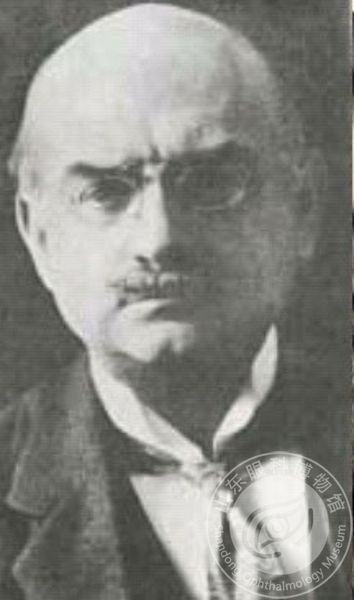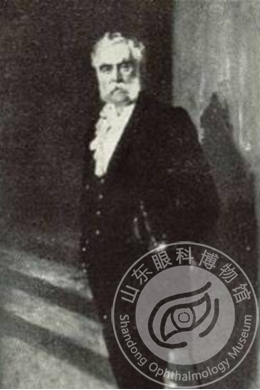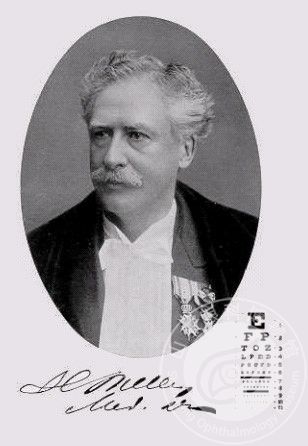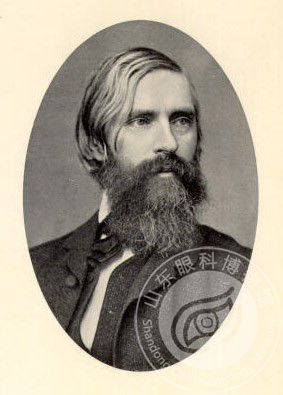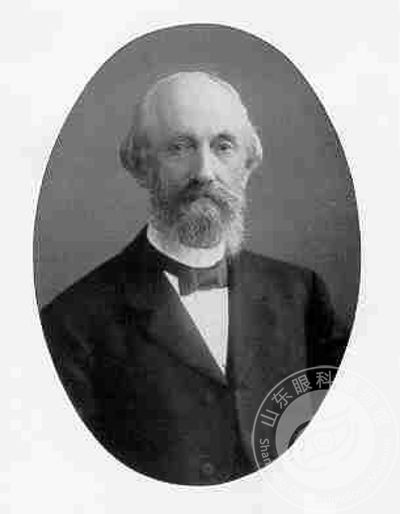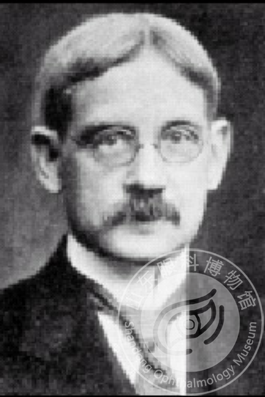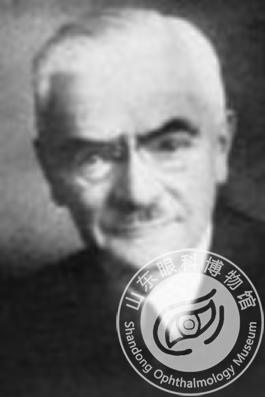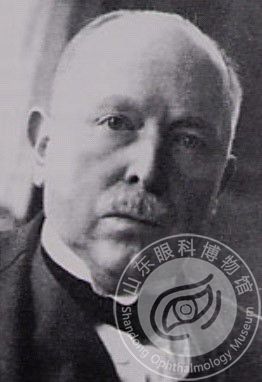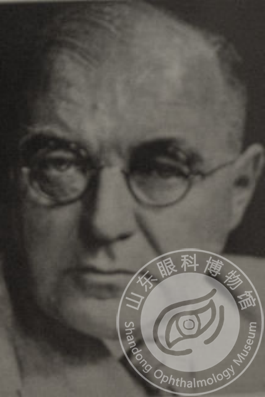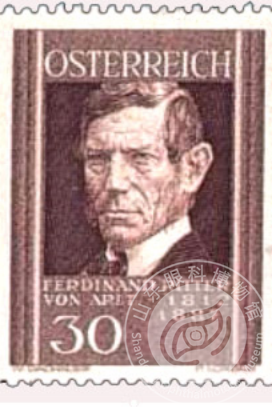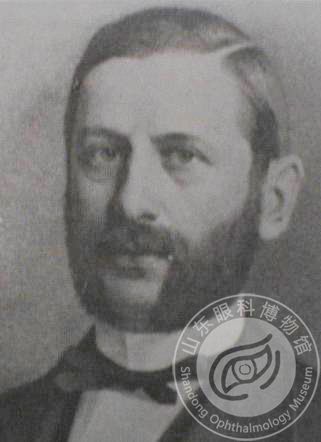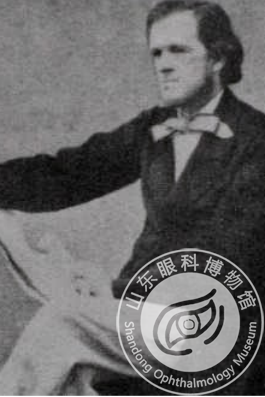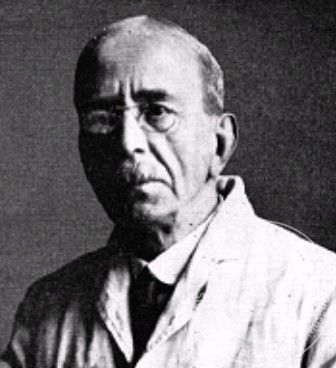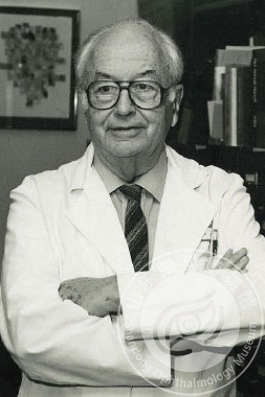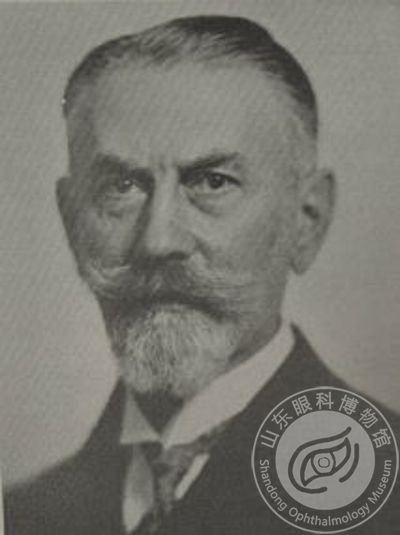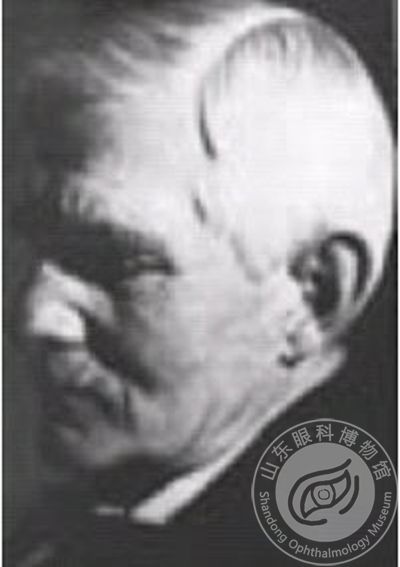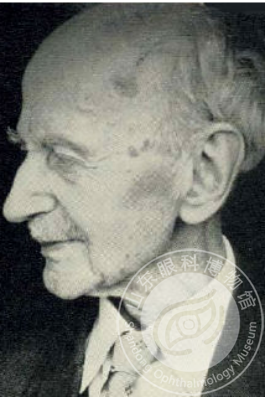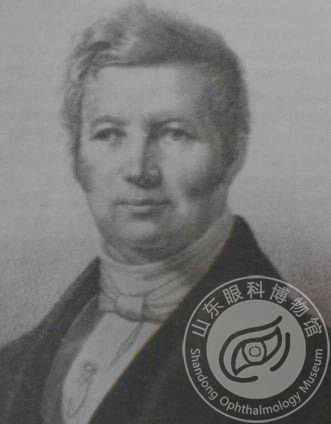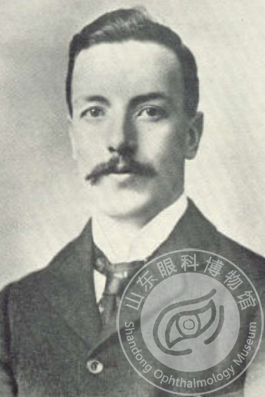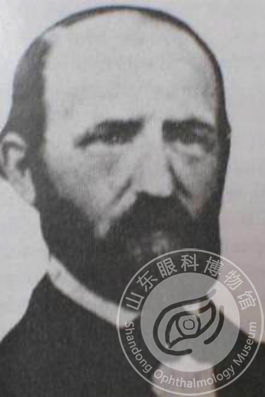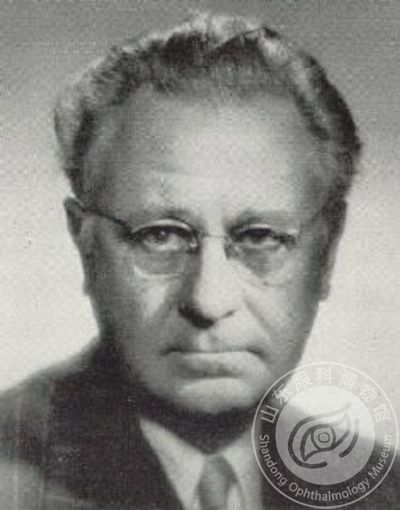Terson's syndrome = Terson described vitreous hemorrhages occurring in patients with subarachnoid hemorrhage and attributed it to a sudden increase in venous pressure that ruptures epipapillary and peripapillary capillaries. About 20% of patients suffering of subarachnoid, or subdural hemorrhages develop intraocular hemorrhages that in most cases are confined at the posterior pole. Intraretinal and subretinal bleeding may also be present, usually from the optic disc and retinal blood vessels. Subhyaloid hemorrhages are usually present. In most cases these hemorrhages clear spontaneously and vision function is unaffected.
Scottish ophthalmologist, born in 1837, Edinburgh; on January 3, 1909, Gonday near Mumbai, India died. Douglas Moray Cooper Lamb Argyll Robertson was one of the first surgeons to focus entirely on the ophthalmology field, and his name was always associated with the phenomenon he described in his pupil in his back. Graefe's scalpel: Designed for cataract extraction, it is now historic.
Argyll Robertson Syndrome: A common symptom of neurosyphilis, particularly back pain, and other diseases of the central nervous system where the pupil is small and slow or not responding at all, but retains response to regulation and convergence.
Dutch ophthalmologist, born 19th February, 1834, Zeist (Utrecht); died 18th January, 1908.
Snellen's charts = Chart printed with lines of black letters used for testing visual acuity.
German ophthalmologist, born on May 22, 1828, in finkenhal, Berlin, Germany (mark Brandenburg);He died in Berlin on July 20, 1870.Graefe's sign: when a patient's gaze changes from looking up to looking down, the upper eyelid cannot follow the eye downward.Graefe's knife: a historically significant knife for cataract extraction.
American ophthalmologist, born on September 1, 1858, Malone, New York; died on June 10, 1926.
Alexander Duane is one of the earliest researchers in the field of ophthalmology and is particularly interested in conditioning and strabismus. He is best known for the translation of the book by Ernst Fuchs, the authority of Vienna. In 1903, the book appeared in English under the name "Fox Eye Science Textbook" and has eight versions.
Duane syndrome: The adduction of the adduction and contraction of the medial and lateral rectus muscles at the same time helps to identify the condition. Duane's retraction syndrome is often mistaken for the sixth nerve paralysis in infancy because of the lack of abduction of the eye involved. In fact, Duane syndrome is common in children as a cause of limited abduction, so it is important to keep this in mind.
German ophthalmologist, born on December 11, 1871, died on April 5, 1940 in New York. Alfred Bielschowsky was born in a Jewish family in Namslau, Lower Silesia. He graduated in 1889 and subsequently entered medical research at the University of Breslau. He quickly moved to Heidelberg, where he graduated in 1891. In the first semester of clinical education, he was influenced by the lecture by Theodor Leber (1840-1917).
His main areas of work are the physiology and pathology of Raumsinn and the movement of the eye. He is a collaborator of Graefe-Saemisch at Handbuch der gesamten Augenheilkunde.
Bielschowsky's head tilt test: an upper oblique muscle paralysis test caused by a fourth cranial nerve injury.
Swiss ophthalmologist, born on October 31, 1879, in Menziken;He died in 1943.Alfred vogt studied at the university of Basel and received his doctorate in 1904.Vogt has developed techniques for retinal endoscopic examination and surgical treatment of retinal detachment.In 1913, he began examining the structure of the front of the eye using a new slit lamp and corneal microscope.Vogt is a leader in ophthalmology and has received the prestigious Donders and Gullstrand MEDALS for his work.Limbal girdle of Vogt: limbal corneal opacity bundle, an arc concentric, at 3 PM and 9 PM and corneal limbus adjacent inside palpebral fissure;Nasal infections are more common than temporary infections, but usually both.Vogt-koyanagi-harada syndrome (VKH) : systemic inflammation involving the eyes and other organs common to some RACES
German ophthalmologist, born on October 28, 1874, died in 1943.
Carl Behr studied at Freiburg, Kiel, Munich and Berlin and received his Ph.D. in Kiel in 1900. He is an intern and assistant physician at the Eppendorfer and St-George hospitals in Hamburg and the eye clinic at Keele University. In 1910, he was engaged in eye science research there. In 1916 he became an extraordinary professor in Kiel and in 1923 he was appointed professor of ophthalmology at Hamburg. His area of particular interest is neuro-ophthalmology, which depicts several new entities, including those now named after him.
Behr's optic atrophy: a recessive form of optic atrophy that may occur alone or may be associated with deafness, diabetes, and neurological complications.
German ophthalmologist, born on April 18, 1812, Obergraupen near Teplitz, Bohemia; died on March 7, 1887. He received ophthalmology training from Professor Johann Nepomuk Fischer (1777-1847), founder of modern ophthalmology medicine in Bohemia, and received his doctorate in medicine in Prague in 1839. From October 1846 to July 1849, he served as the chairman's supplement. Ophthalmology in Prague, August 1849 to July 1856, Professor of Ophthalmology in Prague.
At the beginning of his large-scale work on eye diseases, Arlt began his career at an early stage and in 1855 collaborated with Franz Cornelis Donders (1818-1889) to become a co-editor of Archivfür Ophthalmologie magazine.
Berlin neuroanatomist and psychiatrist born in 1833 died in 1890.Karl friedrich otto westphal was a renowned physician and private medical consultant.From 1851, he studied in Berlin, Heidelberg and Zurich, and received his doctorate in Vienna and Paris.In 1857 westphal became assistant to the charite smallpox branch in Berlin.A year later, he moved to the department of mental disorders as an assistant doctor.In 1861, he was appointed professor of psychiatry at the university of Berlin.In 1868, westphal became head of smallpox and internal medicine.A year later, in 1869, he was appointed distinguished professor of psychiatry, chief physician and clinical teacher of the department of psychiatry and neurological diseases, and full professor of psychiatry in 1874.Edinger-Westphal nucleus: parasympathetic nucleus of the third oculomotor nerve.
German anatomist. Born in Mainz in 1849, he became a lecturer at the University of Heidelberg School of Medicine in 1845. He died in 1984.
Bruch membrane: refers to a thin film-like structure between the choroidal capillary layer and the pigment epithelium of the retina. Because the first is described by Bruch, hence the name.
British neurophysiologist (born 27 November 1857 in London) died 4 March 1952 in eastbourne, Sussex.Sherrington completed his medical course from 1884 to 1887 and was certified by the Royal College of Physicians in 1886.In 1887, sherrington was appointed lecturer in physiology at st Thomas's medical college in London, where he continued to study the spinal cord.From 1891 to 1905, he succeeded Sir Victor Alexander haden horsley (1857-1916) as chief physician at the brown institute, the centre for the study of physiology and pathology in humans and animals.In 1895, sherrington was appointed professor of physiology at Liverpool holt.In 1932, he Shared the Nobel Prize in physiology or medicine with Edgar Douglas Adrian.Sherrington's law: reciprocal innervation law: when a group of muscles is stimulated, the opposite of the activity of the first group of muscles is inhibited.
American ophthalmologist, born in 1908 in Fall River, Massachusetts; died on September 9, 1993, Bethesda.
During his long career, Cogan won many awards. These include the Warren Award in 1944, the Proctor Award in 1954, the Mackenzie Prize in 1968, the 1989 Prevention of Blindness Research Award, and the 1974 Gonin Medal.
Cogan sign in patients with muscle weakness: Cogan's eyelid convulsions. When the patient's eyes are directed downward for 10 to 20 seconds, then the patient is instructed to make a vertical eye jump back to the original position, the upper eyelids rise, either begin to sag slowly or twitch several times in a stable position.
Cogan-Reese disease: a symptom characterized by a mass or smear on the surface of the iris, unilateral glaucoma with multiple peripheral anterior adhesions, multiple nodules in the iris, and ectopic Descemet's meet in the first two years of medical school.
British ophthalmologist,1862 -- 1932.Edward trecher Collins entered Middlesex hospital in 1879 and graduated in 1883.In 1886 he was appointed pathologist and curator of the hospital museum.He held this post until he was appointed hospital surgeon in 1895.As a pathologist, his work in the hospital laid the groundwork for his lectures and the 1896 publication of the anatomy and pathology of the eye.He has made great contributions to the development of ophthalmology at home and abroad.In 1927, he was elected President of the British academy of ophthalmology and the international association of ophthalmologists.His charisma and talent served him well in a difficult period of post-war reconciliation.Treacher Collins syndrome: a defect in the middle and lateral third of the lower eyelid and systemic abnormalities such as maxillofacial muscular atrophy and malformed ears.This is an autosomal dominant disease.
Maddox (1863-1933), a British surgeon and ophthalmologist, an expert in both binocular vision and strabismus (especially strabismus). He has a high level of expertise in optical therapy and has invented a variety of devices for better eye condition research. Including the Markov rod, Markov double prism, Markov red glass, Markov cross and Markov wing. As an enthusiastic astronomy enthusiast, he also invented a lightning arrester that can be placed on stars and constellations.
Maddox rod: An important and indispensable tool for binocular visual function testing. The Markov rod can be used for horizontal and vertical recessive strabismus, rotational recessive strabismus, and unequal image inspection. It has important reference value in evaluating binocular vision function and disposing of binocular vision abnormalities.
Abstract
Although his name is commonly recognized in conjunction with various corneal and anterior segment disorders, Ernst Fuchs' contribution to ophthalmology exceeds purely the delineation of ocular diseases and the detailed description of signs. Fuchs' collection of microscopic samples laid the foundation for anatomical and pathological understanding of blood vessels, muscles, and most other tissues of the eye. Additionally, Fuchs was able to pass on his unique knowledge, educating ophthalmologists at an international level. His textbook was, for many decades, the most extensively used reference book in the field of ophthalmology worldwide.
German ophthalmologist, born on August 3, 1867, in Konigsberg;He died in 1939.Von hippel received his m.d. in gottingen in 1889.Hipper became a doctor in 1890 and was appointed assistant professor of pathology at the university of Heidelberg in 1893.Here he studied severely infected cadavers, which influenced his subsequent research.In 1892 he began to specialize in ophthalmology and became Dr. Leber's assistant.He studied and lectured on ophthalmology and won an award for his research.In 1897, he was appointed Heidelberg distinguished professor.In 1909, von hippel moved to Halley as professor and director of the ophthalmology clinic, and in 1914 to gottingen as professor of ophthalmology.In 1934, due to poor health, he retired.Von hippel is internationally recognized for his work on the pathological anatomy of the eye.Von Hippel-Lindau: a malignant tumor characterized by retinal hemangioma, small cerebrovascular blastoma, and renal tumor.The condition is autosomal dominant and is now located on chromosome 3.
English physician, born in London on May 8, 1863;He died in 1962.Herman David webb was educated at charterhouse college, Cambridge, and studied medicine at st bartholomew's hospital in London, as well as in Cambridge, Paris and Vienna.Weber received his doctorate from Cambridge university in 1892 and was a resident at st. Bartholomew's Hospital, where he served as a surgeon and physician.In 1894 he was appointed honorary doctor of the German hospital, queen's square, London.Parker was the first Mitchell lecturer at the royal college of physicians in 1921.Over 50 years, he has written more than 1,200 medical papers and more than 20 books or chapters.Urge -Weber syndrome: a congenital disorder involving the brain, skin and eyes.Rendu-osler-weber disease: familial syndrome characterized by multiple telangiectasia in the skin, mouth, nasal cavity, conjunctiva, and gastrointestinal mucosa.
German ophthalmologist. Born in 1871, died in 1965. Friedrich Best was born in Wermelskirehen in Rhineland, received early medical and ophthalmology education at Theodore Leber clinic in Heidelberg, then went to Giessen. Under the leadership of Vossius, he became an assistant professor from 1896 to 1905, during which he It took a while. Together with the great physiologist Hering. In 1906 he settled in Dresden until the German branch, and he came to Neidermarsburg in western Germany until his 90th year. In addition to his classic study of macular degeneration, he is always interested in visual physiology and is the first person to use a logarithmic scale when measuring dark adaptation.
Best disease (yolk-like macular dystrophy): Heredofamilial macular degeneration with autosomal dominant inheritance.
German pathologist, born on December 2, 1833, west fallon gutterlow;He died in Strasbourg on August 26, 1910.Friedrich Daniel von Recklinghausen studied medicine in Bonn from 1852 to 1855, and received his m.d. in wurzburg and Berlin in 1855 at the age of 22.In 1865 he was appointed professor of pathological anatomy at konigsberg from 1866 to 1872, he was professor at the university of wurzburg, and finally, from 1872 to 1906, he taught at the university of Strasbourg.He became President of the university in 1877 and was an active researcher and teacher until shortly before his death in 1910.Neurofibroma: genetic disease characterized by coffee milk spots associated with various peripheral nerve tumors, as well as various abnormal hyperplasia of skin, nervous system, bone and endocrine organs.
Professor of anatomy at the Universityof Berlin; born 1795-1858
Schlemm's canal. .
Scottish ophthalmologist, born in 1876, Paisley; died in October 1915.
He began working at the Royal Eye Hospital in London in 1902, became FRCS in 1903, and was appointed curator and pathologist at Moorfields Hospital in 1905. In 1906, he became an assistant ophthalmologist at the Great Northern Central Hospital, at the Royal London Eye Hospital in 1909, and in St. Mary's Hospital in 1911. He has served on the London Teaching Hospital for many appointments. At the time of his death, he was an assistant surgeon and assistant ophthalmologist at the Royal London Eye Hospital at St. Mary's Hospital.
Coats disease: It is a developmental retinal vascular abnormality consisting of leaking telangiectasia and aneurysm retinal blood vessels, associated with associated lipid exudation, a condition that often occurs in the first decade of life. In the eyes.
Müller (1820 - 1864), German physiologist and anatomist. In 1851, Müller noticed the red color in rod cells, now known as rhodopsin or rhodopsin, a pigment present in retinal rod cells. He also described glial cell fibers that make up the retinal support frame, a structure known as "Müller fiber." In 1856, together with his colleague Albert von Korric (1817-1905), he stated that the frog's heart would produce electricity every time it contracted. Since 1858 he has been a full professor at the University of Würzburg. As a lecturer, he also teaches system anatomy, histology and microscopy.
Müller's muscle: The round part of the ciliary muscle of the eye. After the French physiologist Charles Marie Benjamin Rukit (1824-1904), it was also known as "Rouget Muscle". Sometimes referred to as "Müller-Rouget Muscle" to commemorate these two people.
Swedish ophthalmologist, born on July 23, 1899, in copping, malaren, scherer;Died on September 17, 1986, lund.He graduated from karolinska institute in medical science in 1922.He qualified as a doctor in 1927.In 1933, sjoger described his syndrome in his doctoral dissertation severe keratoconjunctivitis.In 1925, he described three cases of salivary gland atrophy associated with dry eyes, dry mouth, and vaginal dryness.In 1957, sjogren became an associate professor at the university of gothenburg and was made an honorary professor in 1961.In 1951 he was elected honorary member of the Australian ophthalmology society, honorary member of the American rheumatic society in 1970, honorary member of the svensk rematoroniak society of forensic medicine and honorary member of the royal college of surgeons of Glasgow in 1976.sjogren's syndrome= is a chronic autoimmune disease characterized by conjunctivitis and dry mouth.
German neurolinguist, born 1851, died 1935.Wilbrand studied in giessen and Strasbourg and received his doctorate in 1875.In 1905 he became director of ophthalmology at agmeny hospital and in 1919 he was appointed professor of ophthalmology.Then he retired.Wilbrand devoted his life to the study of visual physiology and pathology, especially visual pathways and cortical representations and projections.He showed homomorphic hemianopia caused by damage to optical radiation, the occipital cortex, and the optic nerve tract, and discredited the old German physiologist Friedrich Leopold Goltz (1834-1902) theory that the visual center was located under the cortex.
Wilbrand's knee: a group of crossed lower quadrant outer ganglion cells with axons extending forward into the posterior optic nerve.It is considered to be the anatomic basis for contralateral superior quadrant visual field defects found in posterior optic neuropathy.
Turkish dermatologist, born on February 20, 1889, Istanbul; died on March 8, 1948.
Behçet's most important contribution to the medical literature is the monograph "Clinical and Practical Syphilis, Diagnosis and Related Skin Diseases" published in 1940. Each page of the book contains an aspect of syphilis and footnotes and provides a wealth of detailed information about the differential diagnosis of other dermatological conditions. Although the book is outdated, it retains its value and spirit in the medical field and is the only example of the field.
Behçet syndrome: a recurrent systemic disease characterized by uveitis with anterior chamber empyema, recurrent ulceration of the oral and pharyngeal mucosa, and genital ulcers.
Knapp (1832- 1911), German-American ophthalmologist and otolaryngologist. Born in Germany, immigrated to New York.
Knapp's Rule: A lens placed at the front of the eye (usually 15 mm in front of the eye), as long as the difference between the two eyes is due to the difference in length of the eye axis, a similar size will be produced on the retina. image. This is important for correcting refractive errors with the glasses. But there is some controversy about the soundness of the Knapp rule.
Danish ophthalmologist. Born in 1851, died in 1920.
He left the Ribe Cathedral in Denmark in 1869 and completed his medical degree in Copenhagen in 1876. Inspired by Hansen Grout, he quickly became interested in ophthalmology and was appointed as an assistant to Hansen Grout in 1879. Bjerrum's scientific concern is the form of visual perception and the local resolution of the retina. The relationship between capabilities. He argued this in the title "UndersØgeleserofFormsans og Lyssands iforskelligeØjensyngdomme" (a survey of the morphological and light perception of various eye diseases). This title was deliberately given by Denmark, indicating that he must write his publication in Danish throughout his life.
Bjerrum scotoma: The visual field defect feature of glaucoma. It is a nerve fiber bundle defect extending from a blind spot, swept around the macula area and ends in a straight line on the nasal side corresponding to the medial temporal sulcus in the retina.
German anatomist and botanist in Berlin and later Göttingen; born 1727 died 1759
Circle of Zinn.
